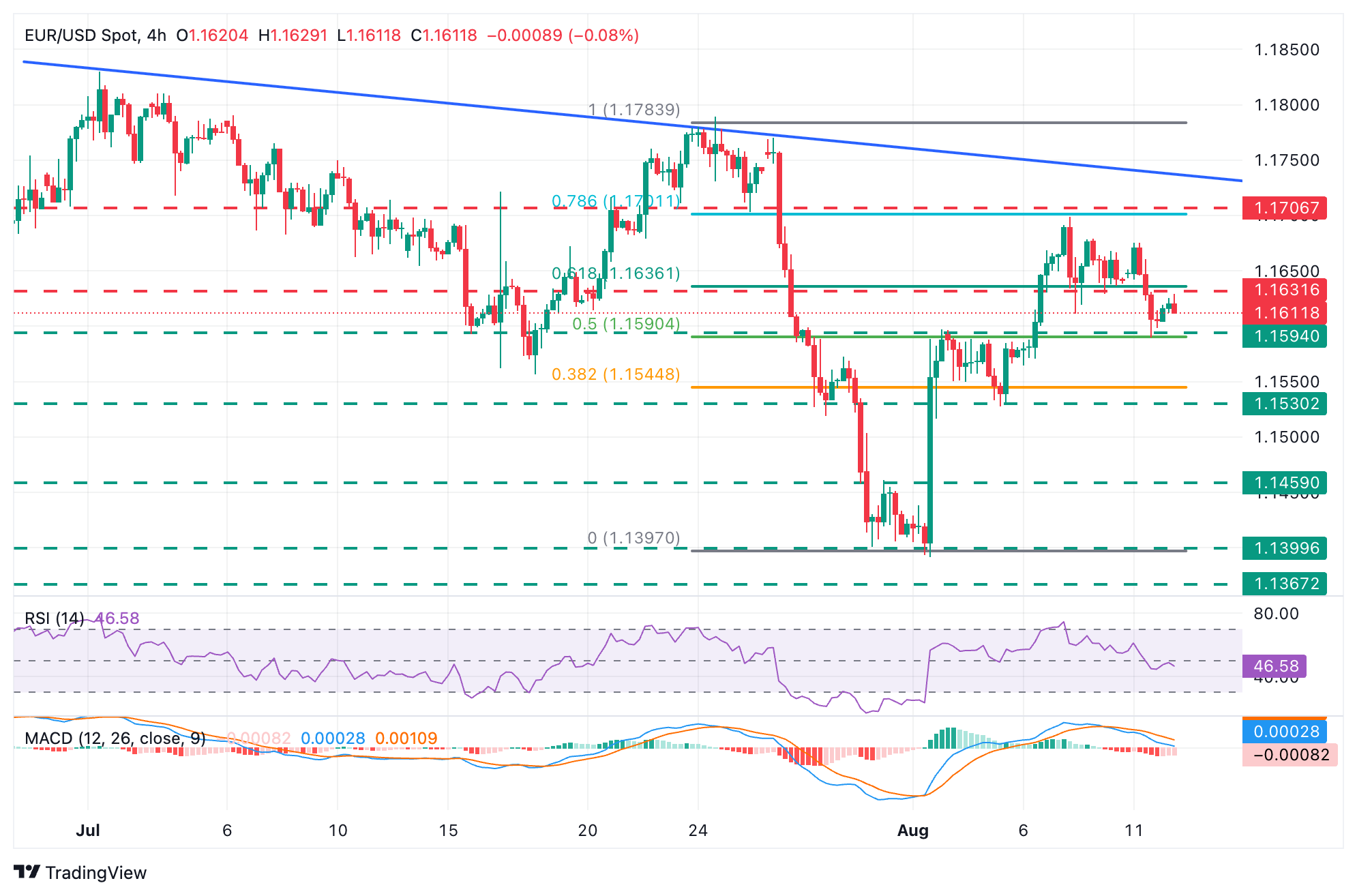EUR/USD turns lower after downbeat German economic sentiment data
- The Euro is hovering above the 1.1600 support area after a reversal from 1.1700 in the past two trading days.
- Economic sentiment data from Germany adds to evidence of the soft momentum of the Eurozone’s Leading economy.
- The focus on Tuesday is on the US CPI report, which is expected to show higher price pressures.
The EUR/USD reversal from 1.1700 highs last week found support at 1.1595, but the pair remains practically flat at the European session opening. The downbeat ZEW Economic Sentiment Index has failed to cheer investors who keep their focus on the US inflation figures, due later on the day, and the comments regarding the Trump-Putin meeting on Ukraine’s war
Data released by the German ZEW institute confirmed that the EU-US trade deal contributed to the deterioration of the economic sentiment, already hit by the weak momentum of the German economy. The report reveals a significant deterioration of the outlook for the chemical and pharmaceutical sectors, with the mechanical, engineering, and metal sectors also severely affected.
On Monday, the Wall Street Journal reported that Russian President Vladimir Putin presented a ceasefire plan in exchange for territorial concessions in Eastern Ukraine. The possibility has been rejected outright by Ukrainian President Volodymyr Zelenskyy, but markets remain hopeful on some sort of peace deal, as Putin will meet US President Donald Trump in Alaska on Friday.
On Tuesday, however, the highlight will be the US Consumer Price Index (CPI) data from July, which is expected to be cautiously analyzed for further clues about the Federal Reserve’s (Fed) next monetary policy steps. Recent labour data and the latest comments by Fed policymakers have boosted hopes that the bank will cut interest rates in September. In this context, the US Dollar will be more sensitive to a strong inflation reading that would curb those expectations.
Regarding global trade, US and China have agreed to extend their truce for another 90 days, averting the implementation of triple-digit reciprocal tariffs. The outcome was widely expected by the market, and its impact has been marginal, but it has added some bearish pressure on the safe-haven US Dollar.
Euro PRICE Today
The table below shows the percentage change of Euro (EUR) against listed major currencies today. Euro was the strongest against the Australian Dollar.
| USD | EUR | GBP | JPY | CAD | AUD | NZD | CHF | |
|---|---|---|---|---|---|---|---|---|
| USD | 0.10% | -0.17% | 0.15% | 0.07% | 0.29% | 0.18% | -0.27% | |
| EUR | -0.10% | -0.26% | 0.07% | 0.00% | 0.23% | 0.11% | -0.32% | |
| GBP | 0.17% | 0.26% | 0.42% | 0.25% | 0.47% | 0.37% | -0.08% | |
| JPY | -0.15% | -0.07% | -0.42% | -0.07% | 0.12% | 0.02% | -0.32% | |
| CAD | -0.07% | -0.00% | -0.25% | 0.07% | 0.25% | 0.10% | -0.33% | |
| AUD | -0.29% | -0.23% | -0.47% | -0.12% | -0.25% | -0.12% | -0.56% | |
| NZD | -0.18% | -0.11% | -0.37% | -0.02% | -0.10% | 0.12% | -0.53% | |
| CHF | 0.27% | 0.32% | 0.08% | 0.32% | 0.33% | 0.56% | 0.53% |
The heat map shows percentage changes of major currencies against each other. The base currency is picked from the left column, while the quote currency is picked from the top row. For example, if you pick the Euro from the left column and move along the horizontal line to the US Dollar, the percentage change displayed in the box will represent EUR (base)/USD (quote).
Daily digest market movers: Currencies remain in range on holiday trade
- Most currencies are moving within previous ranges in a relatively calm start to the week. The US Dollar (USD) Index, which measures the value of the Greenback against the most-traded currencies, is trading flat following a mild recovery over the last two trading days.
- The German ZEW Economic Sentiment Index deteriorated to 34.7 in August from 52.7 in July, well below market expectations for a 40.0 reading. Similarly, the Current Economic Situation index has dropped to -68.6 from -59.5 in July, beyond the -65.0 reading forecasted by market analysts.
- The highlight today is the US Consumer Price Index report. Consumer Inflation is expected to have accelerated to a 2.8% year-on-year rate in July, from 2.7% in June and 2.4% in May. The core CPI, more relevant from the monetary policy perspective, is seen returning to a 3% yearly rate from 2.9% in the previous month.
- After the CPI release, Federal Reserve officials Thomas Barkin and Jeffrey Schmid, both on the hawkish spectrum of the committee, will deliver public comments and might analyze inflation trends, providing further clues about the bank’s monetary policy plans.
Technical Analysis: EUR/USD support at 1.1600 is under pressure

The EUR/USD pair maintains the immediate bullish structure in place, but the bearish momentum is gathering pace after last week’s reversal from 1.1700. The 4-hour Relative Strength Index has entered negative territory below the 50 line, and the MACD has also turned bearish.
The pair has found support at a previous resistance area of 1.1595, which aligns with the August 3 and 5 highs, but failure to return above Friday’s low at 1.1630 might give bears hopes for a deeper reversal. Further down, the next targets would be the August 5 low at around 1.1530 and the July 31 high at 1.1460.
On the upside, the pair would need to extend above the intra-day high at the mentioned 1.1630 to shift the focus back to the 1.1700 area, where the 78.6% Fibonacci retracement of the late-July sell-off meets July 23 and 25 lows, and the descending trendline, now at 1.1735.




